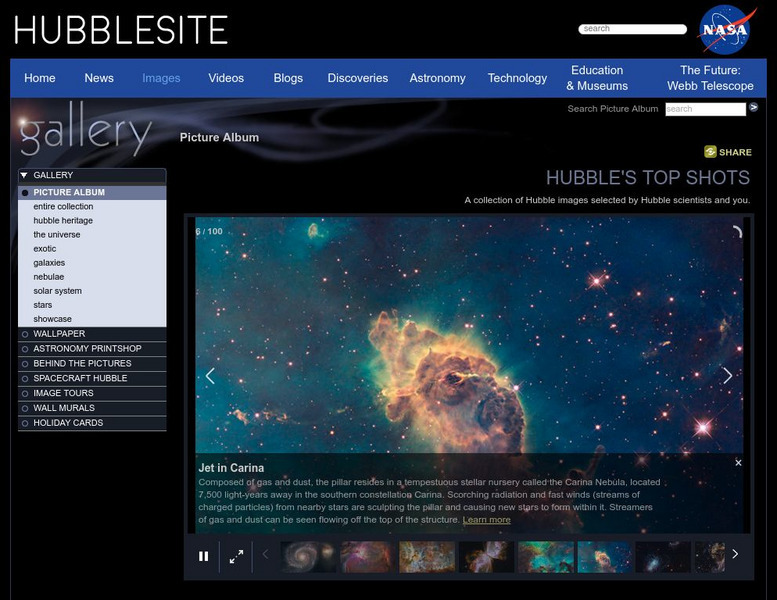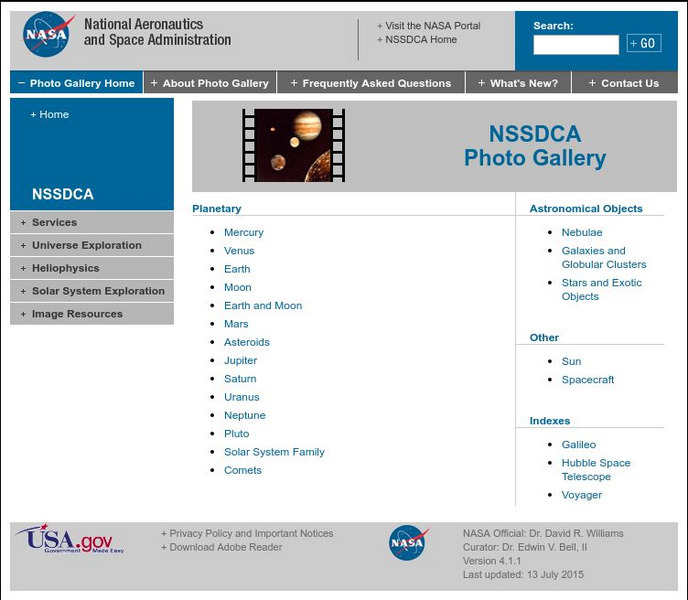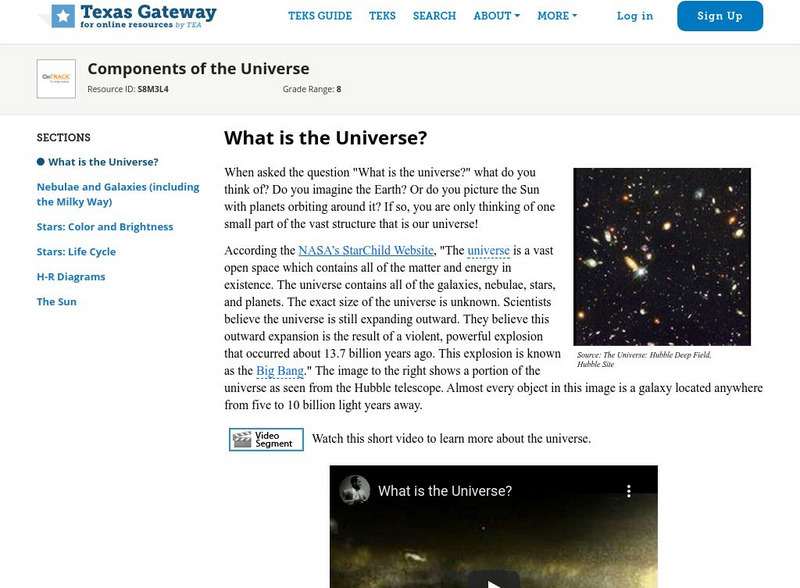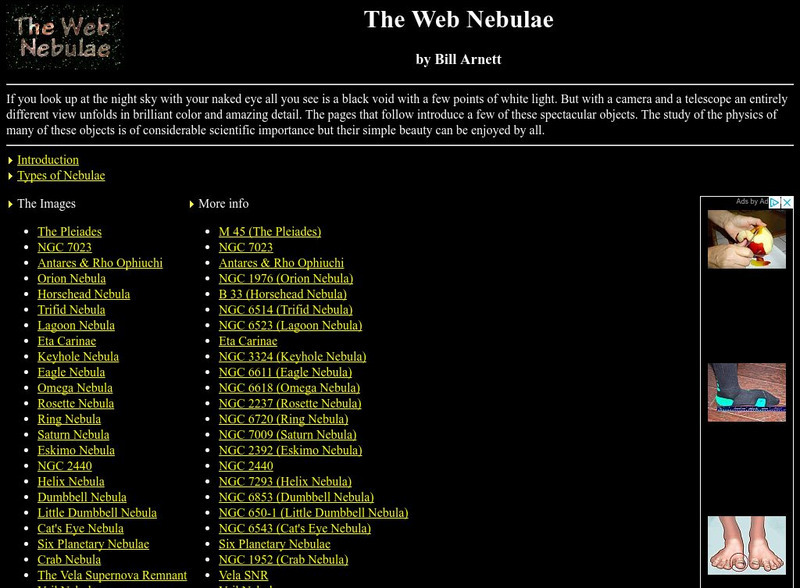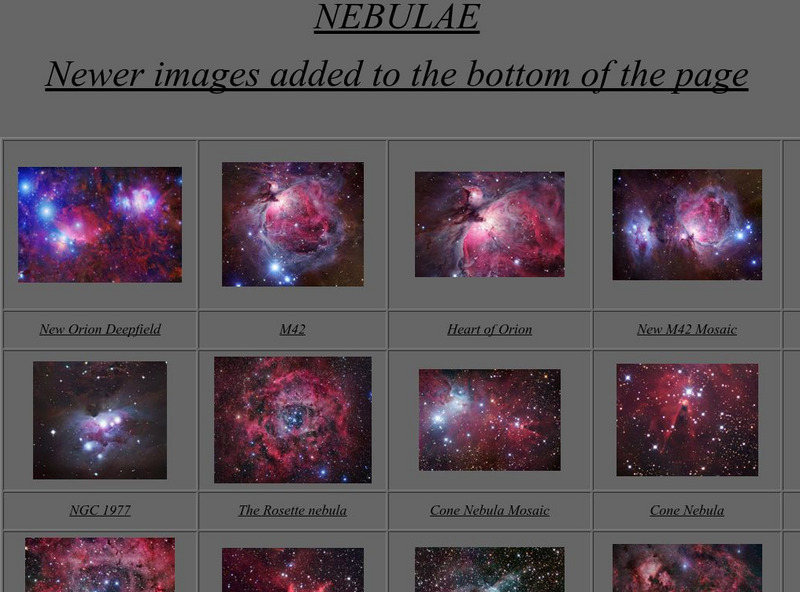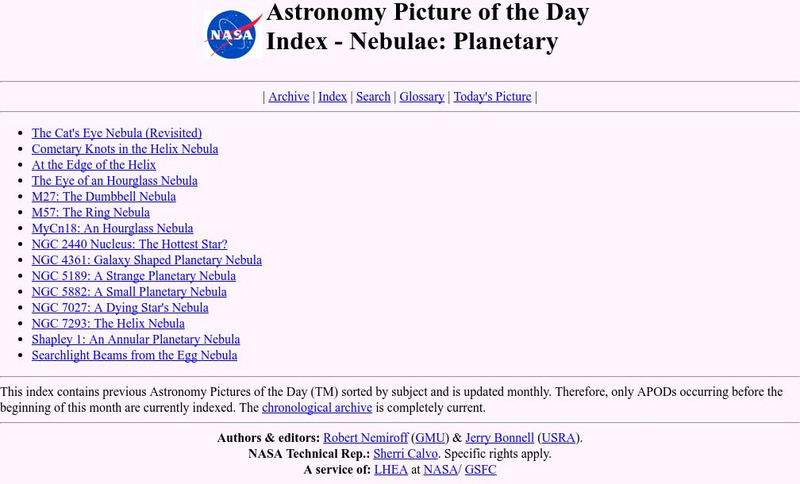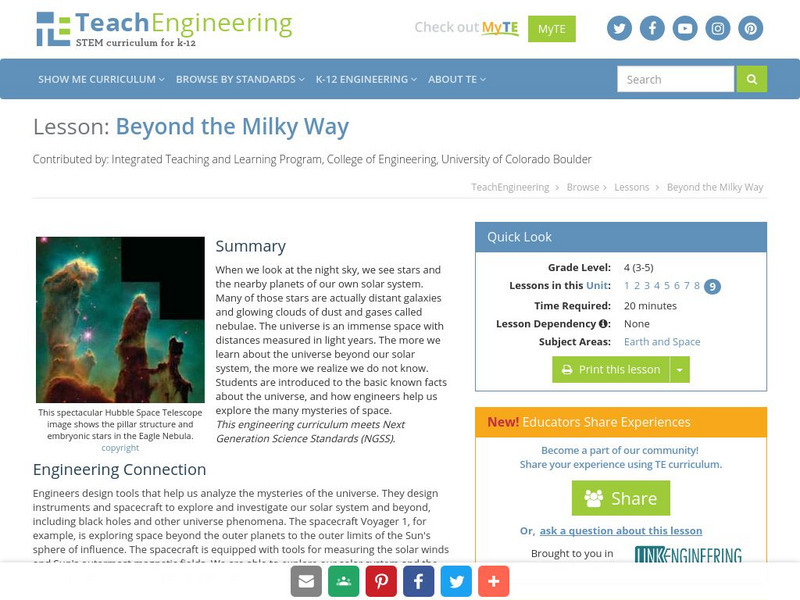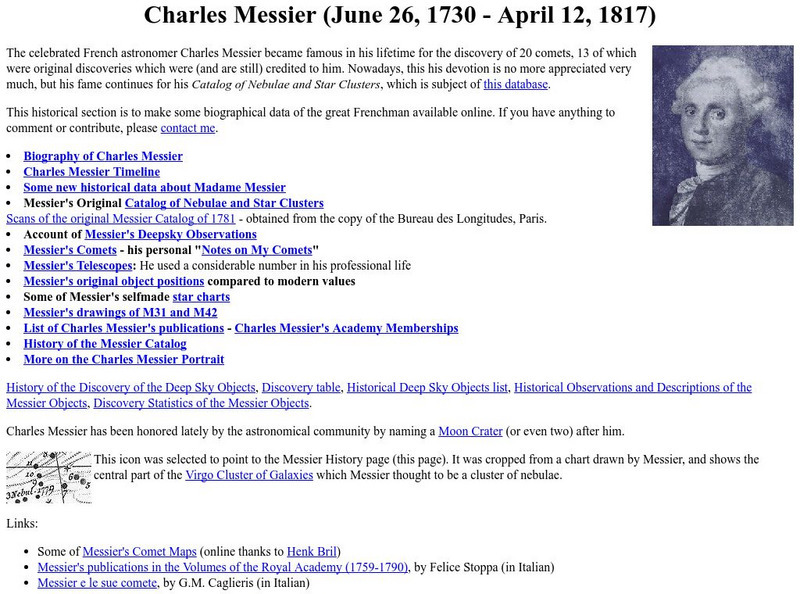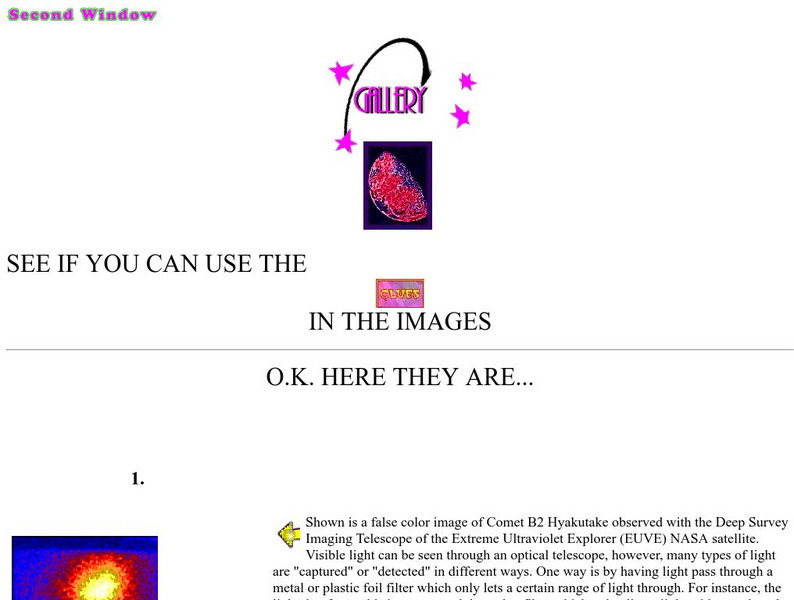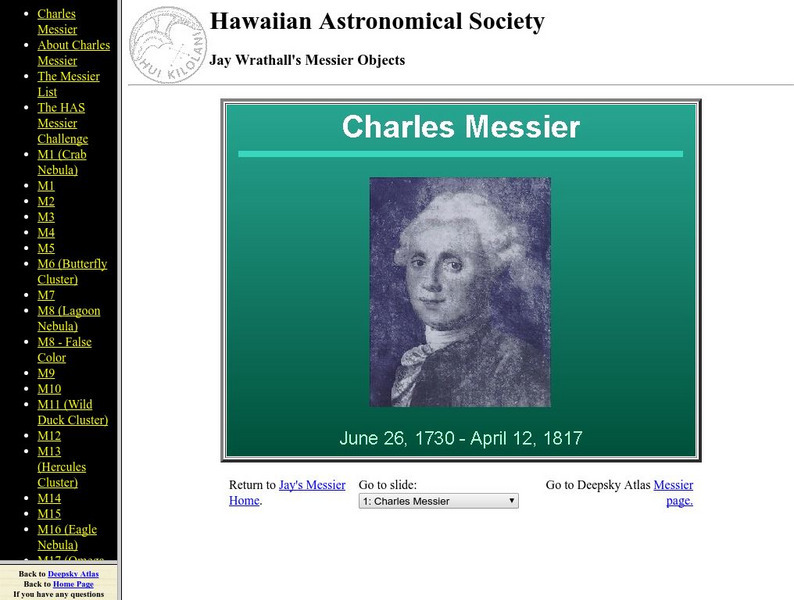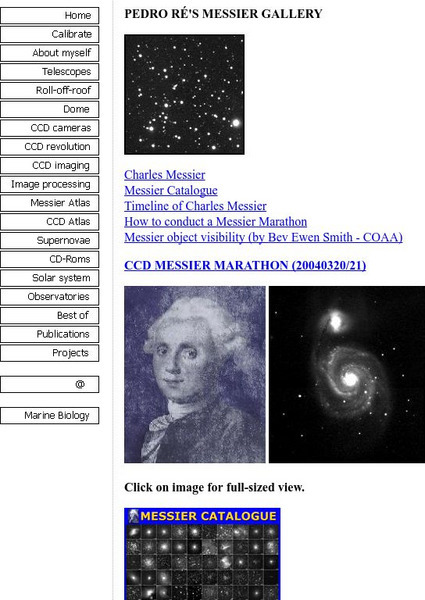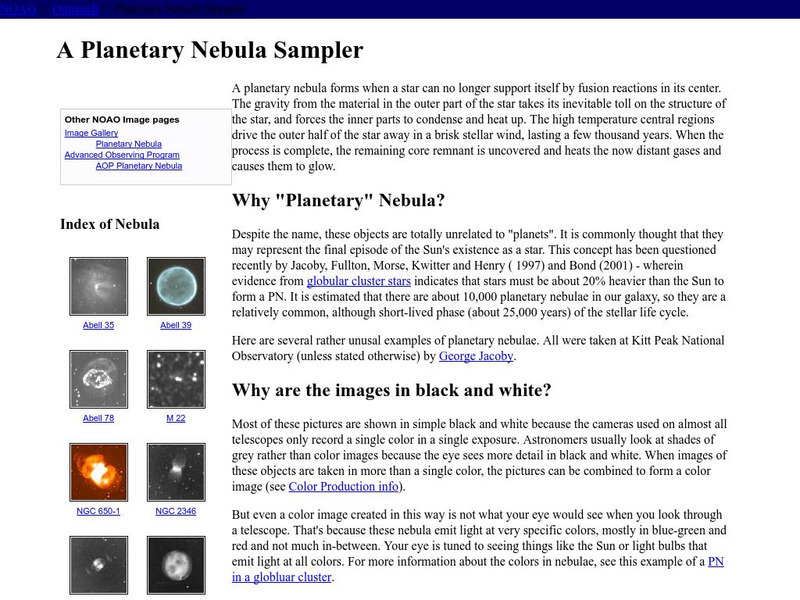Curated OER
Types Of Nebulae
Eighth graders explore the different types of nebulae that can be found in the solar system. They view a PowerPoint presentation about the material and identify each nebulae as it is presented. Students also discuss the life cycle of a...
Space Telescope Science Institute
Hubble Site: Images From Space
This site provides vivid images taken in space by the Hubble Telescope. You can view the entire collection or choose an area you enjoy the most. Explore galaxies, the solar system, nebulae and more!
NASA
Nasa Space Science Data Archive: Photo Gallery
A website featuring a collection of images from NASA. Collection includes images of planets, comets, nebulae, galaxies, stars, sun, and spacecrafts.
NASA
Nasa: Imagine the Universe: Supernovae Remnants
A brief description of supernova remnants with many embedded links to help define terms used in the description. The specific topics are age and the importance of remnants to us and the types. Definitions of key words are provided.
Texas Education Agency
Texas Gateway: What Is the Universe?
The following tutorial is an explanation of what the universe is composed of.
Other
University of Leicester: Spiral Galaxies
Provides a general overview of spiral galaxies, including descriptions of the different classes of spiral galaxy.
Nine Planets
Nine Planets: The Web Nebulae
This site from Nine Planets provides introductory material about nebulae, information and images of several types of nebulae, information on Edwin Hubble, and additional related sites are provided.
Ministerio de Educación (Spain)
Ministerio De Educacion: Medio Interestelar Modulo Vi Unidad 1
In this module you will learn about the interstellar extinction and study about the different types of nebulae and supernova.
Other
Nebulas
Almost 100 images of Nebulas are posted on this amazing site. Magnifications, exposure times, and the name of each nebula are provided.
Other
Nebulas
Almost 100 images of Nebulas are posted on this amazing site. Magnifications, exposure times, and the name of each nebula are provided.
NASA
Nasa: Astronomy Picture of the Day: Nebulae Planetary
At this resource several pictures of nebulae are available with informative caption. Related links and other resources.
Other
Cathing the Light: Nebulae Images Thumbnail Index
A colorful look at the various nebulae with these pictures taken by Jerry Lodriguss. Each picture has background information about the nebula.
TeachEngineering
Teach Engineering: Beyond the Milky Way
When we look at the night sky, we see stars and the nearby planets of our own solar system. Many of those stars are actually distant galaxies and glowing clouds of dust and gases called nebulae. The universe is an immense space with...
Other
Cosmic Wonders: Nebulae
Various different types of nebulae can be explored on this site. View and learn about this stellar phenomena and how they contribute to the growth of the solar system.
Other
Seds Usa: Charles Messier
Charles Messier (1730-1817 CE) is credited for discovering 13 comets. He also began the Catalog of Nebulae and Star Clusters. This catalog as well as a great deal of information on Messier is available here. The Messier objects are also...
NASA
Nasa Space Place: What Is a Nebula?
Learn about nebula and how stars form inside, and see some exciting images.
University of Oregon
The Electronic Universe: Ccd Images of Planetary Nebulae
Basic characteristics of planetary nebulae and the relationship to stellar evolution is presented along with many detailed images.
Other
Sky Server: About Astronomy
This site from SkyServer provides the history of astronomy as well as links to mapping the sky, galaxies, cosmic structures and much more. Several pictures are given, and the article is medium in length.
Other
Planetary Nebulae Observer Home Page
This home page is linked to detailed descriptions of nebulae types, shapes, and structures and their relationship to stellar evolution, a historical perspective on the discovery of nebulae, a gallery of images, and other related resources.
Space Telescope Science Institute
Hubblesite: News Center Release Archive
This site from Hubblesite has a very long list of Hubble Space Telescope Images listed by subject. General categories of subjects include Solar System, Stars, Nebulae, Star Clusters, Novae, Supernovae, Stellar evolutionn, Galaxies, and...
University of California
Center for Science Education: Gallery
A gallery of astronomy images which depict galaxies, comets, the moon, planets, nebulae, supernovae as seen in various regions of the electromagnetic spectrum. Each image in the gallery is described. Fascinating!
Other
Has: Charles Messier
Brief, concise facts about Charles Messier and his catalog of comets, galaxies, and other astronomical bodies. Included are photographs of each of the 110 objects listed in his catalog.
Other
Pedro Re's Messier Gallery
Are you looking for information on Charles Messier? This site includes a detailed biography of his life along with a timeline, how to conduct a Messier Marathon, and photographs of the astronomical objects in Messier's catalog.
Other
National Optical Astronomy Observatory: A Planetary Nebula Sampler
A planetary nebula forms when a star can no longer support itself by fusion reactions in its center. This NOAO site is also illustrated.

